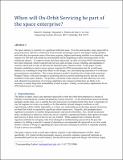When will on-orbit servicing be part of the space enterprise?
Author(s)
Putbrese, Benjamin L.; Hastings, Daniel E; La Tour, Paul Alexis
DownloadActa Astronautica Paper_REVISED_FINAL_3 (1).pdf (1.568Mb)
PUBLISHER_CC
Publisher with Creative Commons License
Creative Commons Attribution
Terms of use
Metadata
Show full item recordAbstract
The space industry is currently at a significant inflection point. Over the past decades, many spacecraft at geosynchronous orbit have continued a trend towards increasingly massive and longer-lasting satellites, and while they do represent some of the most exquisite, highest-performing satellites ever launched, some experts now feel that such trends are unsustainable and are beginning to place increasing strain on the underlying industry. To support current and future spacecraft, on-orbit servicing (OOS) infrastructures have been proposed, which would provide services such as repair, rescue, refueling, and upgrading of customer spacecraft in order to alleviate the identified space industry trends. In this paper, system dynamics modeling is used to assess various scenarios for OOS incorporation into the overall space industry, by evaluating its long-term effects on the design, cost, and underlying experience of a reference geosynchronous constellation. This system dynamics model is based heavily in behavioral economics’ Prospect Theory, with such concepts as anchoring and loss aversion factoring heavily into the overall simulation of the space industry. The primary conclusion of this analysis was that relatively low costs and substantial incorporation of servicing capabilities into customer architectures are likely to be necessary to ensure long-term sustainability of such a project. Finally, several policy implications for an OOS infrastructure are outlined. Keywords: On-orbit servicing; System dynamics; Satellite technology
Date issued
2016-10Department
Massachusetts Institute of Technology. Engineering Systems DivisionJournal
Acta Astronautica
Publisher
Elsevier
Citation
Hastings, Daniel E. et al. “When Will on-Orbit Servicing Be Part of the Space Enterprise?” Acta Astronautica 127 (October 2016): 655–666 © 2016 IAA
Version: Author's final manuscript
ISSN
0094-5765